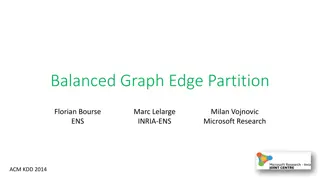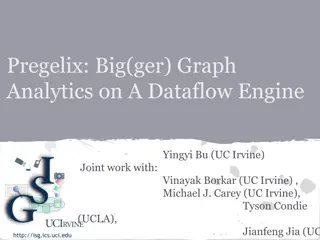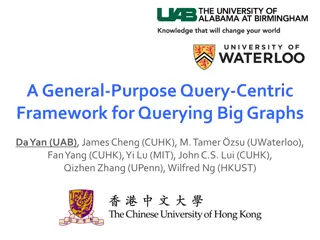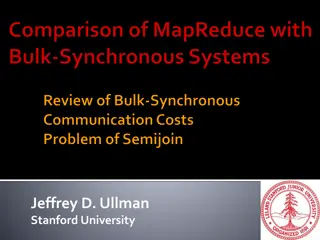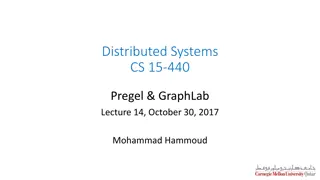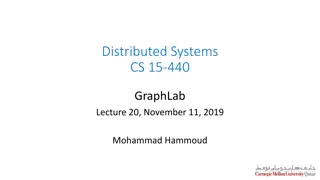
Pregel: A System for Large-Scale Graph Processing
"Learn about Pregel, a system designed to tackle large-scale graph processing challenges by providing scalability, fault-tolerance, and flexibility for implementing various graph algorithms efficiently."
Download Presentation

Please find below an Image/Link to download the presentation.
The content on the website is provided AS IS for your information and personal use only. It may not be sold, licensed, or shared on other websites without obtaining consent from the author. If you encounter any issues during the download, it is possible that the publisher has removed the file from their server.
You are allowed to download the files provided on this website for personal or commercial use, subject to the condition that they are used lawfully. All files are the property of their respective owners.
The content on the website is provided AS IS for your information and personal use only. It may not be sold, licensed, or shared on other websites without obtaining consent from the author.
E N D
Presentation Transcript
PREGEL A System for Large-Scale Graph Processing
The Problem Large Graphs are often part of computations required in modern systems (Social networks and Web graphs etc.) There are many graph computing problems like shortest path, clustering, page rank, minimum cut, connected components etc. but there exists no scalable general purpose system for implementing them. Pregel 2
Characteristics of the algorithms They often exhibit poor locality of memory access. Very little computation work required per vertex. Changing degree of parallelism over the course of execution. Refer [1, 2] Pregel 3
Possible solutions Crafting a custom distributed framework for every new algorithm. Existing distributed computing platforms like MapReduce. These are sometimes used to mine large graphs[3, 4], but often give sub-optimal performance and have usability issues. Single-computer graph algorithm libraries Limiting the scale of the graph is necessary BGL, LEDA, NetworkX, JDSL, Standford GraphBase or FGL Existing parallel graph systems which do not handle fault tolerance and other issues The Parallel BGL[5] and CGMgraph[6] Pregel 4
Pregel Google, to overcome, these challenges came up with Pregel. Provides scalability Fault-tolerance Flexibility to express arbitrary algorithms The high level organization of Pregel programs is inspired by Valiant s Bulk Synchronous Parallel model[7]. Pregel 5
Message passing model A pure message passing model has been used, omitting remote reads and ways to emulate shared memory because: 1. Message passing model was found sufficient for all graph algorithms 2. Message passing model performs better than reading remote values because latency can be amortized by delivering larges batches of messages asynchronously. Pregel 6
Message passing model Pregel 7
Example Find the largest value of a vertex in a strongly connected graph Pregel 8
Finding the largest value in a graph Blue Arrows are messages 3 6 2 1 Blue vertices have voted to halt 3 6 6 6 2 2 1 6 6 6 6 2 6 6 6 6 6 6 6 6 Pregel 9
Basic Organization Computations consist of a sequence of iterations called supersteps. During a superstep, the framework invokes a user defined function foreachvertex which specifies the behavior at a single vertex V and a single Superstep S. The function can: Read messages sent to V in superstep S-1 Send messages to other vertices that will be received in superstep S+1 Modify the state of V and of the outgoing edges Make topology changes (Introduce/Delete/Modify edges/vertices) Pregel 10
Basic Organization - Superstep Pregel 11
Model Of Computation: Entities VERTEX Identified by a unique identifier. Has a modifiable, user defined value. EDGE Source vertex and Target vertex identifiers. Has a modifiable, user defined value. Pregel 12
Model Of Computation: Progress In superstep 0, all vertices are active. Only active vertices participate in a superstep. They can go inactive by voting for halt. They can be reactivated by an external message from another vertex. The algorithm terminates when all vertices have voted for halt and there are no messages in transit. Pregel 13
Model Of Computation: Vertex State machine for a vertex Pregel 14
Comparison with MapReduce Graph algorithms can be implemented as a series of MapReduce invocations but it requires passing of entire state of graph from one stage to the next, which is not the case with Pregel. Also Pregel framework simplifies the programming complexity by using supersteps. Pregel 15
The C++ API Creating a Pregel program typically involves subclassing the predefined Vertexclass. The user overrides the virtual Compute() method. This method is the function that is computed for every active vertex in supersteps. Compute() can get the vertex s associated value by GetValue() or modify it using MutableValue() Values of edges can be inspected and modified using the out-edge iterator. Pregel 16
The C++ API Message Passing Each message consists of a value and the name of the destination vertex. The type of value is specified in the template parameter of the Vertex class. Any number of messages can be sent in a superstep. The framework guarantees delivery and non- duplication but not in-order delivery. A message can be sent to any vertex if it s identifier is known. Pregel 17
The C++ API Pregel Code Pregel Code for finding the max value Class MaxFindVertex : public Vertex<double, void, double> { public: virtual void Compute(MessageIterator* msgs) { int currMax = GetValue(); SendMessageToAllNeighbors(currMax); for ( ; !msgs->Done(); msgs->Next()) { if (msgs->Value() > currMax) } if (currMax > GetValue()) *MutableValue() = currMax; else VoteToHalt(); } }; currMax = msgs->Value(); Pregel 18
The C++ API Combiners Sending a message to another vertex that exists on a different machine has some overhead. However if the algorithm doesn t require each message explicitly but a function of it (example sum) then combiners can be used. This can be done by overriding the Combine() method. -It can be used only for associative and commutative operations. Pregel 19
The C++ API Combiners Example: Say we want to count the number of incoming links to all the pages in a set of interconnected pages. In the first iteration, for each link from a vertex(page) we will send a message to the destination page. Here, count function over the incoming messages can be used a combiner to optimize performance. In the MaxValue Example, a Max combiner would reduce the communication load. Pregel 20
The C++ API Combiners Pregel 21
The C++ API Aggregators They are used for Global communication, monitoring and data. Each vertex can produce a value in a superstep S for the Aggregator to use. The Aggregated value is available to all the vertices in superstep S+1. Aggregators can be used for statistics and for global communication. Can be implemented by subclassing the Aggregator Class Commutativity and Assosiativity required Pregel 22
The C++ API Aggregators Example: Sum operator applied to out-edge count of each vertex can be used to generate the total number of edges in the graph and communicate it to all the vertices. - More complex reduction operators can even generate histograms. In the MaxValue example, we can finish the entire program in a single superstep by using a Max aggregator. Pregel 23
The C++ API Topology Mutations The Compute() function can also be used to modify the structure of the graph. Example: Hierarchical Clustering Mutations take effect in the superstep after the requests were issued. Ordering of mutations, with deletions taking place before additions, deletion of edges before vertices and addition of vertices before edges resolves most of the conflicts. Rest are handled by user-defined handlers. Pregel 24
Implementation Pregel is designed for the Google cluster architecture. The architecture schedules jobs to optimize resource allocation, involving killing instances or moving them to different locations. Persistent data is stored as files on a distributed storage system like GFS[8] or BigTable. Pregel 25
Basic Architecture The Pregel library divides a graph into partitions, based on the vertex ID, each consisting of a set of vertices and all of those vertices out-going edges. The default function is hash(ID) mod N, where N is the number of partitions. The next few slides describe the several stages of the execution of a Pregel program. Pregel 26
Pregel Execution 1. Many copies of the user program begin executing on a cluster of machines. One of these copies acts as the master. The master is not assigned any portion of the graph, but is responsible for coordinating worker activity. Pregel 27
Pregel Execution 2. The master determines how many partitions the graph will have and assigns one or more partitions to each worker machine. Each worker is responsible for maintaining the state of its section of the graph, executing the user s Compute() method on its vertices, and managing messages to and from other workers. Pregel 28
Pregel Execution 2 1 4 5 10 7 8 3 6 9 12 11 Pregel 29
Pregel Execution 3. The master assigns a portion of the user s input to each worker. The input is treated as a set of records, each of which contains an arbitrary number of vertices and edges. After the input has finished loading, all vertices are marked are active. Pregel 30
Pregel Execution 4. The master instructs each worker to perform a superstep. The worker loops through its active vertices, and call Compute() for each active vertex. It also delivers messages that were sent in the previous superstep. When the worker finishes it responds to the master with the number of vertices that will be active in the next superstep. Pregel 31
Pregel Execution Pregel 32
Pregel Execution Pregel 33
Fault Tolerance Checkpointing is used to implement fault tolerance. At the start of every superstep the master may instruct the workers to save the state of their partitions in stable storage. This includes vertex values, edge values and incoming messages. Master uses ping messages to detect worker failures. Pregel 34
Fault Tolerance When one or more workers fail, their associated partitions current state is lost. Master reassigns these partitions to available set of workers. They reload their partition state from the most recent available checkpoint. This can be many steps old. The entire system is restarted from this superstep. Confined recovery can be used to reduce this load Pregel 35
Applications PageRank Pregel 36
PageRank PageRank is a link analysis algorithm that is used to determine the importance of a document based on the number of references to it and the importance of the source documents themselves. [This was named after Larry Page (and not after rank of a webpage)] Pregel 37
PageRank A = A given page T1 . Tn = Pages that point to page A (citations) d = Damping factor between 0 and 1 (usually kept as 0.85) C(T) = number of links going out of T PR(A) = the PageRank of page A ( T ) ( T ) ( T ) PR T PR T PR T = + + + + ( ) 1 ( ) ( ........ ) 1 2 n PR A d d ( ) ( ) ( ) C C C 1 2 n Pregel 38
PageRank Courtesy: Wikipedia Pregel 39
PageRank PageRank can be solved in 2 ways: A system of linear equations An iterative loop till convergence We look at the pseudo code of iterative version Initial value of PageRank of all pages = 1.0; While ( sum of PageRank of all pages numPages > epsilon) { for each Page Pi in list { PageRank(Pi) = (1-d); for each page Pj linking to page Pi { PageRank(Pi) += d (PageRank(Pj)/numOutLinks(Pj)); } } } Pregel 40
PageRank in MapReduce Phase I Parsing HTML Map task takes (URL, page content) pairs and maps them to (URL, (PRinit, list-of-urls)) PRinitis the seed PageRank for URL list-of-urls contains all pages pointed to by URL Reduce task is just the identity function Pregel 41
PageRank in MapReduce Phase 2 PageRank Distribution Map task takes (URL, (cur_rank, url_list)) For each u in url_list, emit (u, cur_rank/|url_list|) Emit (URL, url_list) to carry the points-to list along through iterations Reduce task gets (URL, url_list) and many (URL, val) values Sum vals and fix up with d Emit (URL, (new_rank, url_list)) Pregel 42
PageRank in MapReduce - Finalize A non-parallelizable component determines whether convergence has been achieved If so, write out the PageRank lists - done Otherwise, feed output of Phase 2 into another Phase 2 iteration Pregel 43
PageRank in Pregel Class PageRankVertex : public Vertex<double, void, double> { public: virtual void Compute(MessageIterator* msgs) { if (superstep() >= 1) { double sum = 0; for (; !msgs->done(); msgs->Next()) *MutableValue() = 0.15 + 0.85 * sum; } if (supersteps() < 30) { const int64 n = GetOutEdgeIterator().size(); SendMessageToAllNeighbors(GetValue() / n); } else { VoteToHalt(); }}}; sum += msgs->Value(); Pregel 44
PageRank in Pregel The pregel implementation contains the PageRankVertex, which inherits from the Vertex class. The class has the vertex value type double to store tentative PageRank and message type double to carry PageRank fractions. The graph is initialized so that in superstep 0, value of each vertex is 1.0 . Pregel 45
PageRank in Pregel In each superstep, each vertex sends out along each outgoing edge its tentative PageRank divided by the number of outgoing edges. Also, each vertex sums up the values arriving on messages into sum and sets its own tentative PageRank to For convergence, either there is a limit on the number of supersteps or aggregators are used to detect convergence. + . 0 15 . 0 85 sum Pregel 46
Applications Shortest Paths Pregel 47
Shortest Path There are several important variants of shortest paths like single-source shortest path, s-t shortest path and all-pairs shortest path. We shall focus on single-source shortest path problem, which requires finding a shortest path between a single source vertex and every other vertex in the graph. Pregel 48
Shortest Path Class ShortestPathVertex : public Vertex<int, int, int> { public: virtual void Compute(MessageIterator* msgs) { int minDist = IsSource((vertex_id()) ? 0 : INF; for ( ; !msgs->Done(); msgs->Next()) minDist = min(minDist, msgs->Value()); if (minDist < GetValue()) { *MutableValue() = minDist; OutEdgeIterator iter = GetOutEdgeIterator(); for ( ; !iter.Done(); iter.Next()) SendMessageTo(iter.target(), } VoteToHalt(); } }; minDist + iter.GetValue()); Pregel 49
Shortest Path In this algorithm, we assume the value associated with every vertex to be INF (a constant larger than any feasible distance). In each superstep, each vertex first receives, as messages from its neighbors, updated potential minimum distances from the source vertex. If the minimum of these updates is less than the value currently associated with the vertex, then this vertex updates its value and sends out potential updates to its neighbors, consisting of the weight of each outgoing edge added to the newly found minimum distance. Pregel 50

